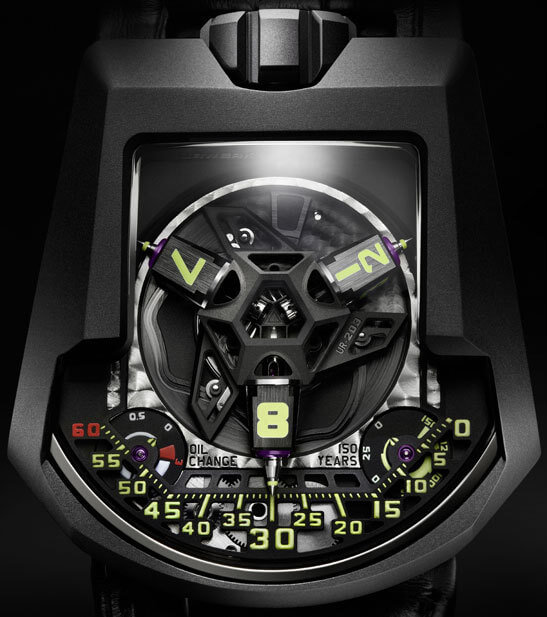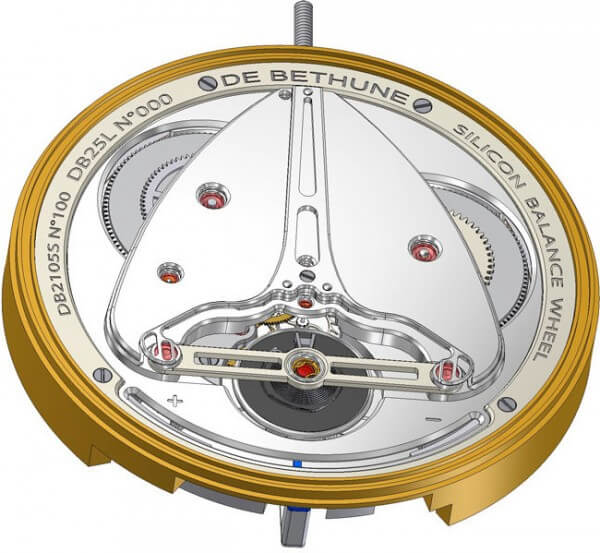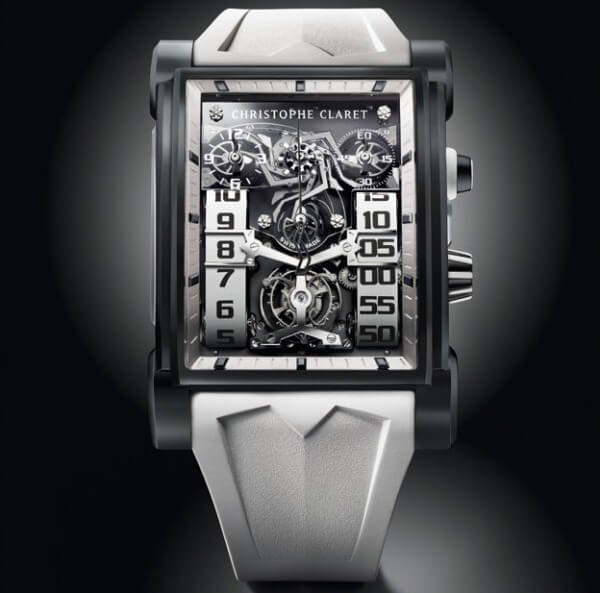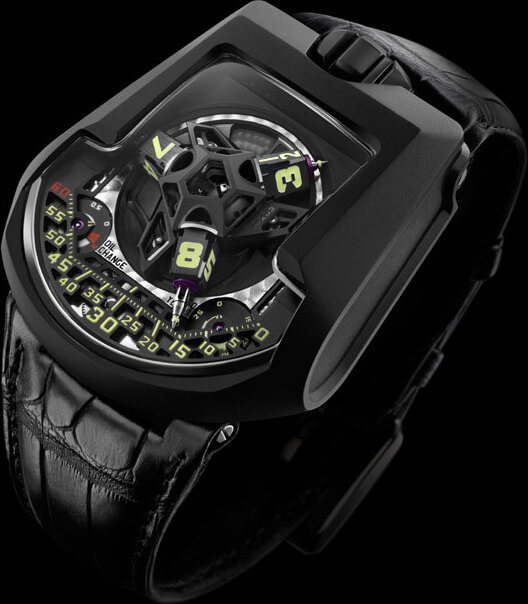Urwerk’s UR-203
The UR-203, like the UR-202, incorporates a satellite complication with telescopic hands. The hours are displayed on three four-sided satellites which orbit the dial and rotate around themselves. The hands retract and extend to indicate the minutes. In the new edition, limited to 20 pieces, this complication has been pared down to the bare essentials. It is made from Arcap, its structure skeletonised to whittle the weight of the components by 65%. Achieving such minimalism meant taking the satellite module back to the drawing board for a complete redesign. The UR-203 also incorporates two original functions from Urwerk. The “Oil Change” indicator tells the wearer when a service is due (recommended every three years) while the “Horological Odometer” calculates the total number of years, up to 150, the movement has been in operation. The UR-203 features an innovative self-winding system that is regulated by a twin turbine coupled to the rotor. Winding is optimal in the “Free” position, slowed by close to 35% in the “Sport” position, and inactive in the “Stop” position when the watch is manually wound.

The new de Bethune calibre
The new Calibre DB2105s from de Bethune is the company’s first series movement to feature an annular silicon balance wheel. In its search for the most efficient balance possible, de Bethune has produced a model which allows optimum adjustment with minimum energy loss. Comprising a silicon disc edged with a platinum ring, it remains perfectly poised after assembly for a significant increase in efficiency. The balance spring incorporates de Bethune’s flat terminal curve, tried and tested since 2004. Together they integrate the Calibre DB2105s, a hand-wound, 30mm movement that drives the two models unveiled this year in the DB25 collection. One presents a hand-guilloché silvered dial with a three-dimensional moon phase at 12 o’clock. This moon is composed of two semi-spheres, one in platinum and one in blued steel. One hundred and twenty-three years must pass for it to register a deviation of one day. The blued steel dial of the second model is studded with gold stars, created through extremely delicate hand-crafting. Once again, the spherical moon takes its place at 12 o’clock.

Christophe Claret’s DualTow
Christophe Claret is a creator of complex and innovative movements whose Manufacture celebrated its 20th anniversary in 2009. He commemorated this milestone with the first timepiece to bear his name, a reflection of his philosophy and a merging of the expertise that surrounds him in his company. The DualTow, now commercially available, is intended for enlightened collectors who are invited to personalise their model. Hence each of the 68 watches in the limited edition will be unique.
A single-pusher planetary-gear chronograph with striking mechanism and tourbillon, the DualTow houses several inventions including one patent. The major innovation lies in the chronograph function, which operates in the spectacular form of three planetary gears. The 60-minute counter at 11 o’clock and the 60-second counter at 1 o’clock are displayed on a sapphire crystal with the chronograph seconds hand in the centre. The chronograph activation system can be admired at 12 o’clock. This patented complication has virtually no impact on the regularity of the movement’s rate, thereby optimising its precision. The DualTow also includes an original striking mechanism that sounds when the chronograph is started, stopped and reset.

The tourbillon in its distinctive carriage is at 6 o’clock, while the tourbillon bridge is personalised as the back-to-back double C cipher. Hours and minutes are displayed left and right by notched rubber belts turning under forks. These belts are driven by cylinders, the sides of which are designed to resemble the wheel rims of a Bugatti T35. The mechanical, hand-wound CC20A Calibre has a power reserve of some 60 hours, supplied by two barrels. The barrels’ ratchet wheels also evoke a Bugatti T35 wheel rim. In a stunning mise en scène, the DualTow’s mechanisms are visible from the front, back and also side through openings in the rectangular, curved case.

















